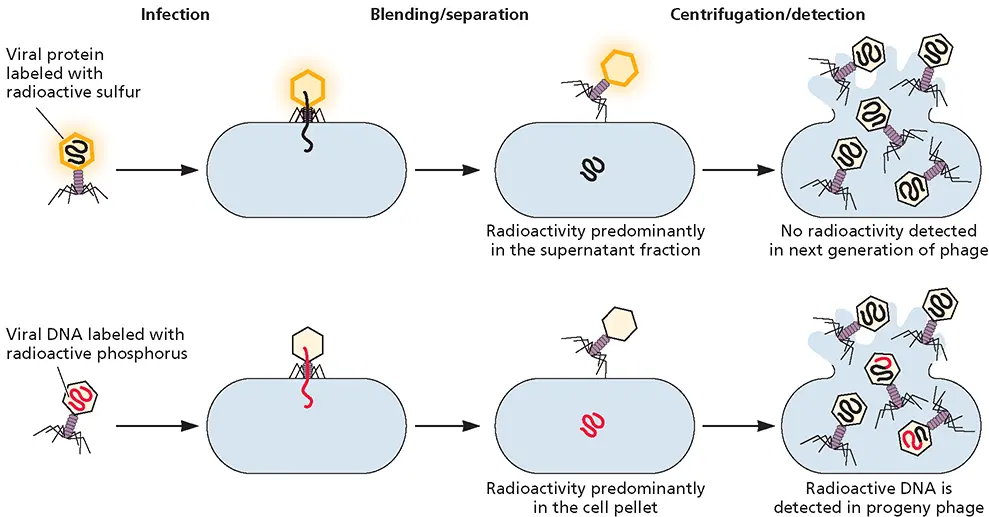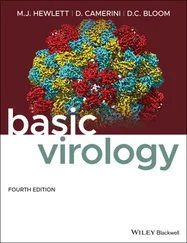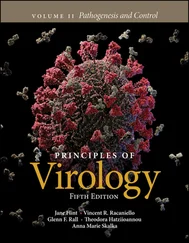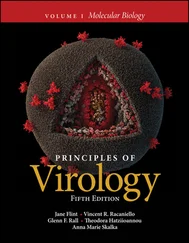Jane Flint - Principles of Virology
Здесь есть возможность читать онлайн «Jane Flint - Principles of Virology» — ознакомительный отрывок электронной книги совершенно бесплатно, а после прочтения отрывка купить полную версию. В некоторых случаях можно слушать аудио, скачать через торрент в формате fb2 и присутствует краткое содержание. Жанр: unrecognised, на английском языке. Описание произведения, (предисловие) а так же отзывы посетителей доступны на портале библиотеки ЛибКат.
- Название:Principles of Virology
- Автор:
- Жанр:
- Год:неизвестен
- ISBN:нет данных
- Рейтинг книги:3 / 5. Голосов: 1
-
Избранное:Добавить в избранное
- Отзывы:
-
Ваша оценка:
- 60
- 1
- 2
- 3
- 4
- 5
Principles of Virology: краткое содержание, описание и аннотация
Предлагаем к чтению аннотацию, описание, краткое содержание или предисловие (зависит от того, что написал сам автор книги «Principles of Virology»). Если вы не нашли необходимую информацию о книге — напишите в комментариях, мы постараемся отыскать её.
Volume I: Molecular Biology
Volume II: Pathogenesis and Control
Principles of Virology, Fifth Edition
Principles of Virology — читать онлайн ознакомительный отрывок
Ниже представлен текст книги, разбитый по страницам. Система сохранения места последней прочитанной страницы, позволяет с удобством читать онлайн бесплатно книгу «Principles of Virology», без необходимости каждый раз заново искать на чём Вы остановились. Поставьте закладку, и сможете в любой момент перейти на страницу, на которой закончили чтение.
Интервал:
Закладка:
Bacteriophages became inextricably associated with the new field of molecular biology. Their study established many fundamental principles: for example, control of the decision to enter a lysogenic or a lytic pathway is encoded in the genome of the virus. The first mechanisms discovered for the control of gene expression, exemplified by the elegant operon theory of Nobel laureates François Jacob and Jacques Monod, were deduced in part from studies of lysogeny by phage lambda. The biology of phage lambda provided a fertile ground for work on gene regulation, but study of virulent T phages (T1 to T7, where T stands for “type”) of E. coli paved the way for many other important advances. As we shall see, these systems also provided an extensive preview of mechanisms of animal virus reproduction ( Box 1.7).
Animal Cells as Hosts
The culture of animal cells in the laboratory was initially more of an art than a science, restricted to cells that grew out of organs or tissues maintained in nutrient solutions under sterile conditions. Cells so obtained from living tissues, called primary cells, have a finite life span. Their dependence for growth on natural components in their media such as lymph, plasma, or chicken embryo extracts, and the technical demands of sterile culture prior to the discovery of antibiotics, made reproducible experimentation very difficult. However, by 1955, the work of many investigators had led to a series of important methodological advances. These included the development of defined media optimal for growth of mammalian cells, incorporation of antibiotics into cell culture media, and development of immortal cell lines such as the mouse L and human HeLa cells that are still in widespread use. These advances allowed growth of animal cells in culture to become a routine, reproducible exercise.
BOX 1.5
EXPERIMENTS
The Hershey-Chase experiment
By differentially labeling the nucleic acid and protein components of virus particles with radioactive phosphorus ( 32P) and radioactive sulfur ( 35S), respectively, Alfred Hershey and Martha Chase showed that the protein coat of the infecting virus could be removed soon after infection by agitating the bacteria for a few minutes in a blender. In contrast, 32P-labeled phage DNA entered and remained associated with the bacterial cells under these conditions. Because such blended cells produced a normal burst of new virus particles, it was clear that the DNA contained all of the information necessary to produce progeny phages.

The availability of a variety of well-characterized animal cell cultures had several important consequences for virology. It allowed the discovery and propagation of new human viruses, such as adenovirus, measles virus, and rubella virus, for which animal hosts were not available. In 1949, John Enders and colleagues used cell cultures to propagate poliovirus, a feat that led to the development of polio vaccines a few years later. Cell culture technology revolutionized the ability to investigate the reproduction of viruses. Viral infectious cycles could be studied under precisely controlled conditions by employing the analog of the one-step growth cycle of bacteriophages and simple methods for quantification of infectious particles described in Chapter 2.
Our current understanding of the molecular basis of viral parasitism, the focus of this volume, is based almost entirely on analyses of one-step growth cycles in cultured cells. Such studies established that viruses depend absolutely on the biosynthetic machinery of their host cells for synthesis of the components from which progeny viral particles are built. In contrast to cells, viruses are not reproduced by growth and division. Rather, the infecting genome contains the information necessary to redirect cellular systems to the production of many copies of all the components needed for the de novo assembly of new virus particles. It is remarkable, however, that while viruses lack the complex energy-generating and biosynthetic systems necessary for independent existence ( Box 1.8), they are notthe simplest biologically active agents: viroids, which are infectious agents of a variety of economically important plants, comprise a single small molecule of noncoding RNA, whereas agents called prions, which cause neurological disease in humans and animals, are thought to be aggregates of single protein molecules (Volume II, Chapter 13).
BOX 1.6
BACKGROUND
Properties of lysogeny shared with animal viruses
Lytic versus Lysogenic Response to Infection
Some bacterial viruses can enter into either destructive (lytic) or relatively benign (lysogenic) relationships with their host cells. Such bacteriophages were called temperate. In a lysogenic bacterial cell, viral genetic information persists but viral gene expression is repressed. Such cells are called lysogens, and the quiescent viral genome, a prophage. By analogy with the prophage, an integrated DNA copy of a retroviral genome in an animal genome is termed a provirus.
Propagation as a Prophage
For some bacteriophages like lambda and Mu (Mu stands for “mutator”), prophage DNA is integrated into the host genome of lysogens and passively replicated by the host. Virally encoded enzymes, known as integrase (lambda) and transposase (Mu), mediate the covalent insertion of viral DNA into the chromosome of the host bacterium, establishing it as a prophage. The prophage DNA of other bacteriophages, such as P1, exists as a plasmid, a self-replicating, autonomous chromosome in a lysogen. Both forms of propagation have been identified in certain animal viruses, for example, retroviruses and a lethal herpesvirus.
Insertional Mutagenesis
Bacteriophage Mu inserts its genome into many random locations on the host chromosome, causing numerous mutations by disrupting host DNA sequences. This process is called insertional mutagenesis and is a phenomenon observed with retroviruses.

Pioneers in the study of lysogeny: Nobel laureates François Jacob, Jacques Monod, and André Lwoff, 1965.Courtesy of the U.S. National Library of Medicine.
Gene Repression and Induction
Prophage gene expression in lysogens is turned of by the action of viral proteins called repressors. Expression can be turned on when repressors are inactivated (a process called induction). The discovery that genes can be regulated by such trans- acting proteins, and elucidation of their mechanism, set the stage for later investigation of the control of gene expression with other viruses and their host cells.
Transduction of Host Genes
Bacteriophage genomes can pick up cellular genes and deliver them to new cells (a process known as transduction). For example, occasional mistakes in excision of the lambda prophage from its host chromosome after induction result in production of unusual progeny phages that have lost some of their own DNA but have acquired the bacterial DNA adjacent to the prophage. The acute transforming retroviruses also arise via capture of genes in the vicinity of their integration as proviruses (Volume II, Chapter 6). These cancer-inducing cellular genes are then transduced along with viral genes during subsequent infection.
Читать дальшеИнтервал:
Закладка:
Похожие книги на «Principles of Virology»
Представляем Вашему вниманию похожие книги на «Principles of Virology» списком для выбора. Мы отобрали схожую по названию и смыслу литературу в надежде предоставить читателям больше вариантов отыскать новые, интересные, ещё непрочитанные произведения.
Обсуждение, отзывы о книге «Principles of Virology» и просто собственные мнения читателей. Оставьте ваши комментарии, напишите, что Вы думаете о произведении, его смысле или главных героях. Укажите что конкретно понравилось, а что нет, и почему Вы так считаете.











